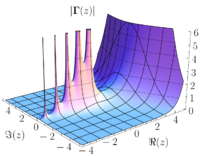Analyticity of holomorphic functions
| Mathematical analysis → Complex analysis |
| Complex analysis |
|---|
 |
| Complex numbers |
| Complex functions |
| Basic theory |
| Geometric function theory |
| People |
In complex analysis, a complex-valued function of a complex variable :
- is said to be holomorphic at a point if it is differentiable at every point within some open disk centered at , and
- is said to be analytic at if in some open disk centered at it can be expanded as a convergent power series (this implies that the radius of convergence is positive).
One of the most important theorems of complex analysis is that holomorphic functions are analytic and vice versa. Among the corollaries of this theorem are
- the identity theorem that two holomorphic functions that agree at every point of an infinite set with an accumulation point inside the intersection of their domains also agree everywhere in every connected open subset of their domains that contains the set , and
- the fact that, since power series are infinitely differentiable, so are holomorphic functions (this is in contrast to the case of real differentiable functions), and
- the fact that the radius of convergence is always the distance from the center to the nearest non-removable singularity; if there are no singularities (i.e., if is an entire function), then the radius of convergence is infinite. Strictly speaking, this is not a corollary of the theorem but rather a by-product of the proof.
- no bump function on the complex plane can be entire. In particular, on any connected open subset of the complex plane, there can be no bump function defined on that set which is holomorphic on the set. This has important ramifications for the study of complex manifolds, as it precludes the use of partitions of unity. In contrast the partition of unity is a tool which can be used on any real manifold.
Proof
The argument, first given by Cauchy, hinges on Cauchy's integral formula and the power series expansion of the expression
Let be an open disk centered at and suppose is differentiable everywhere within an open neighborhood containing the closure of . Let be the positively oriented (i.e., counterclockwise) circle which is the boundary of and let be a point in . Starting with Cauchy's integral formula, we have
Interchange of the integral and infinite sum is justified by observing that is bounded on by some positive number , while for all in
for some positive as well. We therefore have
on , and as the Weierstrass M-test shows the series converges uniformly over , the sum and the integral may be interchanged.
As the factor does not depend on the variable of integration , it may be factored out to yield
which has the desired form of a power series in :
with coefficients
Remarks
- Since power series can be differentiated term-wise, applying the above argument in the reverse direction and the power series expression for gives This is a Cauchy integral formula for derivatives. Therefore the power series obtained above is the Taylor series of .
- The argument works if is any point that is closer to the center than is any singularity of . Therefore, the radius of convergence of the Taylor series cannot be smaller than the distance from to the nearest singularity (nor can it be larger, since power series have no singularities in the interiors of their circles of convergence).
- A special case of the identity theorem follows from the preceding remark. If two holomorphic functions agree on a (possibly quite small) open neighborhood of , then they coincide on the open disk , where is the distance from to the nearest singularity.









![{\displaystyle {\begin{aligned}f(z)&{}={1 \over 2\pi i}\int _{C}{f(w) \over w-z}\,\mathrm {d} w\\[10pt]&{}={1 \over 2\pi i}\int _{C}{f(w) \over (w-a)-(z-a)}\,\mathrm {d} w\\[10pt]&{}={1 \over 2\pi i}\int _{C}{1 \over w-a}\cdot {1 \over 1-{z-a \over w-a}}f(w)\,\mathrm {d} w\\[10pt]&{}={1 \over 2\pi i}\int _{C}{1 \over w-a}\cdot {\sum _{n=0}^{\infty }\left({z-a \over w-a}\right)^{n}}f(w)\,\mathrm {d} w\\[10pt]&{}=\sum _{n=0}^{\infty }{1 \over 2\pi i}\int _{C}{(z-a)^{n} \over (w-a)^{n+1}}f(w)\,\mathrm {d} w.\end{aligned}}}](https://wikimedia.org/api/rest_v1/media/math/render/svg/b8e6cbb27553e01d97842e63d6a283e2792a2267)













